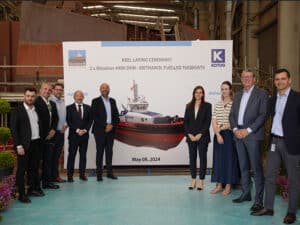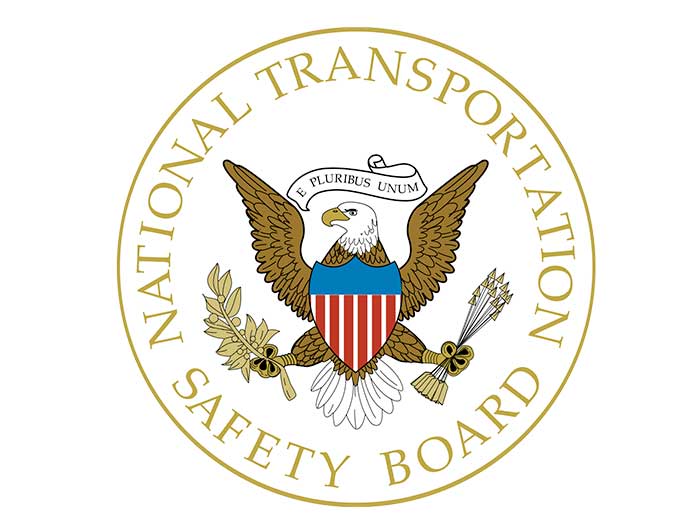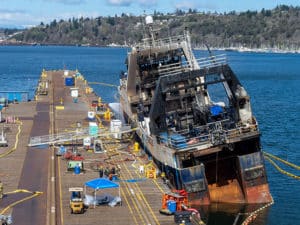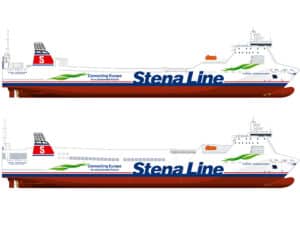
NTSB reports on $12.3 million collision between bulker and OSV
Written by Nick Blenkey
The bridge watch officers on a bulk carrier and an offshore supply vessel (OSV) were not maintaining a proper lookout before a collision last year near Port Fourchon, Louisiana, the National Transportation Safety Board said Tuesday.
The incident occurred on July 23, 2022, at about 1314 local time ,when the bulk carrier Bunun Queen, transiting eastbound in the Gulf of Mexico with 20 crew members on board, and the northbound offshore supply vessel Thunder collided about 66 miles south of Port Fourchon, Louisiana.
Damage to both vessels was estimated at $12.3
The Thunder, operated by Jackon Offshore Operators, sustained substantial damage to its port side, which resulted in the flooding of one of its propulsion rooms and three other spaces. Eleven of Thunder’s 18 crew were evacuated to a Good Samaritan vessel, and the remaining crew stayed with the vessel to control the flooding while it was towed back to port. There were no injuries, and no pollution was reported.
The Thunder sustained damage to its port side aft consisting of a large penetration above and below its waterline that caused flooding in the port side propulsion room, the port cargo tank (empty at the time), a void space, and the no. 7 port ballast tank. The cost of repairs was about $11,598,078.
The 590-foot-long bulk carrier Bunun Queen was owned by Unicorn Pescadores, S.A., and operated by Wisdom Marine International, based in Taipei, Taiwan.
Damage to the Bunun Queen’s port bow consisted of indentations and deformation of the shell plating above the waterline at water ballast tank no. 1 port. The vessel’s bulbous bow sustained multiple dents, a crack, and a hull fracture of the shell plating, which caused water to enter the forepeak tank. The cost of repairs was about $680,000.
GOOD VISIBILITY AND FAIR WEATHER
The collision occurred in good visibility, daylight and fair weather conditions. Each of the vessel’s automatic radar and plotting aid displays and automatic identification system receivers were able to detect the other vessel. In the time leading up to the collision, neither of the vessels’ officer on watch maintained a lookout—either by visual scanning or using the available electronic systems to prevent a collision. Both officers on watch stated they were engaged in non-navigational tasks. The master on the Thunder was using his cell phone and the second officer on the Bunun Queen was engaged in other duties.
The NTSB report note that the Convention on the International Regulations for Preventing Collisions at Sea (COLREGS) requires “every vessel shall at all times maintain a proper lookout by sight and hearing as well as by all available means appropriate.”
CELL PHONE UE
The NTSB determined the probable cause of the collision was the Bunun Queen officer’s distraction due to performing non-navigational tasks and the Thunder officer’s distraction due to cell phone use, which kept both officers from keeping a proper lookout. Contributing to the casualty was the Thunder’s officer on watch not following his company’s watchkeeping policies.
“Using cell phones and other personal electronic devices has been demonstrated to be visually, manually, and cognitively distracted,” the report said. “Nonoperational use of cell phones and other wireless electronic devices by on-duty crewmembers in safety-critical positions has been a factor in accidents in all transportation modes. Nonoperational use of cell phones should never interfere with the primary task of a watchstander or a bridge team member to maintain a proper lookout. It is important for personnel to follow established protocols regarding cell phone use.”
- Download Marine Investigation Report 23-09 HERE




